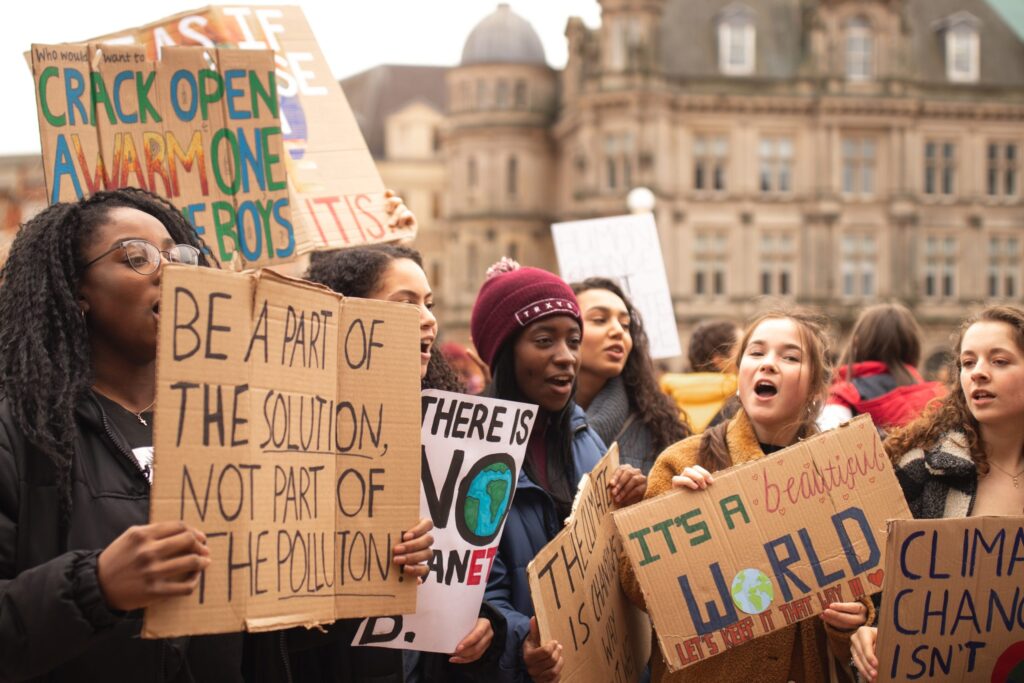Nicky Woolf is a journalist and editor who specialises in the intersection of politics, technology, and digital subculture. He was a US correspondent for The Guardian, and launched New Statesman America, a US sister-publication to the New Statesman magazine.
On January 6, a monster that I’ve been watching for several years move and grow in the shadows emerged into the daylight for the first time. When the mob of Trump supporters stormed the US Capitol building, it wasn’t just about the then-President and his unruly supporters. There was something even more sinister behind it – a phenomenon that doesn’t just present an immediate and present threat of violence, but the existence of which undermines the very concept of truth itself.
One of the starkest photos from that day is of a man standing on the Speaker’s dais in the House of Representatives. He is topless apart from war paint, and he is wearing a fur hat with horns, and brandishing a spiked flagpole. He is Jake Angeli, and he is known as the Q Shaman.
QAnon is often called a conspiracy theory, but this is entirely inaccurate. It includes the accusation that there is a conspiracy at the height of US and global government – in particular, that it is run by a cabal of paedophiles led by Hillary Clinton – but that is just a part of a wide-ranging and arcane belief system.
It is more accurate to look at QAnon as a new religion. It has a prophet: an anonymous poster calling themselves Q who claims to be a high-ranking official in the US national security administration (the name Q is a reference to Q-level security clearance, the equivalent of Top Secret clearance in the US Department of Energy, which maintains and operates America’s arsenal of nuclear weapons). It has a whole galaxy of popes and priests.
It has its core text, too: the backlog of Q posts, which believers cite like biblical verses. This originated as a long-running series of posts on 4chan and later 8chan – febrile anonymous message-boards that form the sweaty engine-room of the internet. They are gnomic puzzles, things onto which people can project whatever they want.
Followers call themselves “bakers” because they are “following the breadcrumbs” of Q’s posts, hungrily devouring them across a wide range of social media outlets. Here’s an example from November 2017:
BIG DROP:
How did NK obtain Uranium?
How did Iran obtain Uranium?
Why did BO send billions (in cash and wire) to Iran?
Why the cash component?
Was the hostage component a cover?
For what?
Could any of the cash component be handed off to other people?
How many planes carried the cash into Iran?
Did all land in Iran?
Did all land in the same location?
Why is this relevant?
Who controls NK?
Who really controls NK?
Don’t think of a single person.
Think of a powerful entity.
Why is this important?
Who benefits?
What does hostage refer to?
Why are wars so important?
Where is BO TODAY?
Where is VJ?
Who can be held hostage and controlled by NK having miniaturized nuclear weapons?
Alice & Wonderland.
These posts are as clever in how much they don’t say as what they actually do: the internet subculture podcast Reply All have described them as “horoscopes for boomers.” But it is where and how they originate that is most important about them.
The culture of chan-style boards is immensely powerful and crucial to understand. You may not have visited or even heard of them, but you will have experienced their influence in some way or another through pranks, memes, and other phenomena that have made their way in various forms from these places into the mainstream.
If you’ve seen or shared any meme, it is likely a format born and developed on 4chan (the most powerful chan site) or its ilk. Anonymous, the powerful “hacktivist” collective, originates there and takes their name from it – posts by users on these ‘chan sites’ all bear the name as their moniker, and the sites denizens call themselves “anons” in reference to it, which is also what the “anon” part of the name “QAnon” is a reference to.
Pizzagate – the conspiracy theory that went viral in 2016 which held that Hillary Clinton was running a child sex operation out of the basement of a suburban italian restaurant in Washington DC – was also a chan site phenomenon, and is a partial precursor to QAnon.
Pizzagate was also a chilling demonstration of how such things can make the jump from the digital realm to the real world: in December 2016, a 28-year-old believer went to the restaurant – called Comet Ping Pong – in order to “investigate” the theory himself. He arrived armed with a military-grade rifle, and opened fire, loosing three rounds. Miraculously, in this case, nobody was hurt, and he surrendered to police after they surrounded the building.
There is an intriguing theory developed by a pair of Danish academics I interviewed a while back called the Gutenberg Parenthesis. It holds that the period between the invention of the printing press and the invention of the internet was an exception – a parenthetical aside from the natural way in which humans exchange information.
the period between the invention of the printing press and the invention of the internet was an exception – a parenthetical aside from the natural way in which humans exchange information
During the parenthesis, the flow of information was controlled by gatekeepers – at first the church, then the state, and then eventually the free press. In network infrastructure terms, information flowed outwards from supernodes to the rest of the network.
This was not always a perfect system, of course. But the internet, the theory goes, has blown that structure out of the water entirely. We now live in an era where once again information flows across a flat network, from person to person – that’s social media. And in that ecosystem, no unit of information is able to gain any weight over any other through being vouched-for by gatekeepers. In essence, the problem is that on a flat network “truth” has exactly the same power as any other story.
In 1951, Hannah Arendt, in her seminal work The Origins of Totalitarianism, wrote:
Arendt’s insight was that the totalitarian regimes of Hitler’s Germany and Stalin’s USSR had monopolised the information ecosystem and hijacked it using propaganda, which allowed them to gain complete control over their population. They did this by creating a cognitive dissonance: if everything was at the same time both true and untrue, then the human mental mechanisms for distinguishing truth from lies breaks down, leaving a population under the control of the regime in a way that could be helpfully understood as a kind of self-perpetuating mass hypnosis.
Here’s the problem when it comes to evidence-based policy and the discussion of same: the dawning of the internet and social media age – the closing of the Gutenberg parenthesis – has created an ecosystem in which that kind of cognitive dissonance has been able to develop under its own steam. Terrifyingly, it has created the environment in which it can evolve by itself.
QAnon is thus not an organisation at all: it is an organic emergent phenomenon, a digital life-form in its own right. It has leaders – Angeli, the “shaman” who was part of the mob that stormed the US Capitol, is one of a large group of QAnon “influencers” who participate in the movement and help spread its message, forming a sort of cleric class.
But while there is someone (or more likely, a number of people who have changed over the course of the last couple of years since its inception) behind the Q posts themselves, QAnon is now much greater than the sum of its parts.
There have been no new “Q drops”, as the posts are known, since last December, but the movement has its own momentum now – a momentum which Trumpism attempted to harness, and which led to the January 6th attack.
Youtube and Facebook need to take their share of the blame for creating this ecosystem, and it is a relief that the big social media platforms seem to finally be acting to prevent the spread of QAnon on their networks. It is a shame that it took a literal massed attack on the seat of US government to make Silicon Valley sit up and take notice of what was happening on their watch. But it is possible that QAnon is not going to be the last of these phenomena.
What really worries me is the real possibility that it simply represents how things look from here on out – that there will … be a direct correlation between … frictionlessness in communication technology and a trend toward social chaos
What really worries me is the real possibility that it simply represents how things look from here on out – that the genie cannot be put back in to the bottle, and that there will turn out to be a direct correlation between a trend toward frictionlessness in communication technology and a trend toward social chaos.
Trump’s election didn’t happen in a vacuum – it was a separate part of this same change in information ecosystem. 4chan users like to joke that they “memed a president into the white house.” There is a real danger that they are correct.
So far, so alarmist. Happily, there are some counterfactuals to this thesis. Not every digital community trends toward anarchy. The best example of a situation where a digital community has organically achieved not just cohesion but has become effectively a self-regulating and self-perpetuating digital information repository – a supernode, in the language of the Gutenberg Parenthesis – is Wikipedia, the largest and most accurate information repository humanity has ever produced.
The reason for its success is similar to the reason QAnon has become so successful: the construction of a continuing grassroots community that, with little or no top-down interference, can maintain itself in perpetuity. Any possibility of building or maintaining understanding of evidence-based policy in the future must be constructed on similar foundations.
a continuing grassroots community that, with little or no top-down interference, can maintain itself in perpetuity … evidence-based policy in the future must be constructed on similar foundations
Twitter’s recent announcement that it is building a Wiki-like operation for fact-checking content, called Birdwatch, is at least a step in the right direction – though they will face huge challenges in reaching the kind of critical participatory mass required for success. But the model must now be organic in structure, and focus on building self-regulating communities instead of top-down rigid structures – or risk being King Canute trying to hold back the informational tide.
What that means in practice for think tanks and other organisations seeking to understand how information flows in the 21st century is that approaching groups via their leaders or influencers is no longer sufficient. Phenomenon like QAnon or Wikipedia are organic communities; engaging with them or predicting their behaviour requires the kind of mapping of movement and data that previously might have been in the realm of mass ethnography or epidemiology.
There will need to be much more joined-up thinking across fields. The time when expertise can be focused in a single topic area – American politics, say – is over. The nation-state can no longer be the sole focus of political analysis, because digital movements like QAnon are becoming something like non-geographical nation-states in their own right.
It might even be useful (and here I’m showing my science fiction nerd upbringing) to think of the fictional field of “psychohistory” as described by Isaac Asimov in the Foundation series. In the novel, Asimov describes how this new field – mass psychological modelling – is able to predict the movement of peoples and the downfall of empires. Think tanks might do well to move toward that kind of mathematical modelling of communication network structures in order to understand how people on them will behave, and how their behaviour is influenced.
That will require, most likely, technological solutions: to create accurate models of this complexity will need powerful machine-learning software, for example. But it will likely pay huge dividends. The price for not adapting to this brave new digital world will be extinction.





